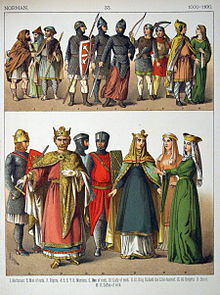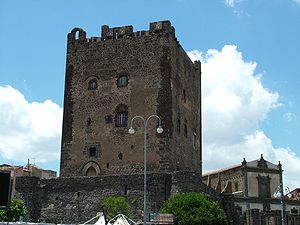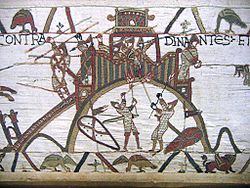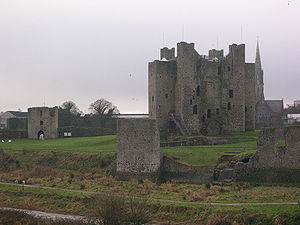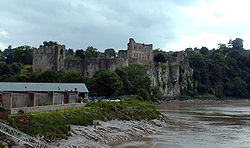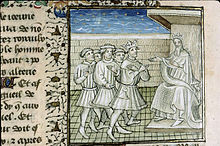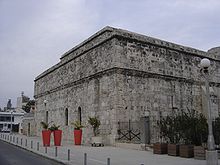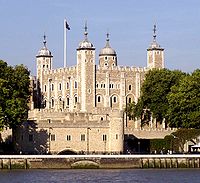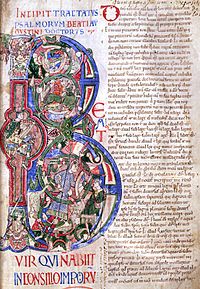- Normans
-
This article is about the people. For other uses, see Norman (disambiguation).
The Normans were the people[1] who gave their name to Normandy, a region in northern France. They were descended from Norse Viking conquerors of the territory and the native population of Frankish[2] and Gallo-Roman stock.[3] Their identity emerged initially in the first half of the 10th century, and gradually evolved over succeeding centuries.
They played a major political, military, and cultural role in medieval Europe and even the Near East. They were famed for their martial spirit and eventually for their Christian piety. They quickly adopted the Romance language of the land they settled, their dialect becoming known as Norman or Norman-French, an important literary language. The Duchy of Normandy, which they formed by treaty with the French crown, was one of the great fiefs of medieval France. The Normans are famed both for their culture, such as their unique Romanesque architecture, and their musical traditions, as well as for their military accomplishments and innovations. Norman adventurers established a kingdom in Sicily and southern Italy by conquest, and a Norman expedition on behalf of their duke led to the Norman Conquest of England. Norman influence spread from these new centres to the Crusader States in the Near East, to Scotland and Wales in Great Britain, and to Ireland.
Contents
Etymology
The English name "Normans" comes from the French words Normans / Normanz, plural of Normant,[4]that is itself borrowed from Old Low Franconian Nortmann "Northman"[5] or directly from Old Norse Norðmaðr, Latinized in Nortmannus (recorded in Medieval Latin, 9th century) to mean "Norseman" or "Viking".[6]
Characteristics
11th century Benedictine monk and historian, Geoffrey Malaterra characterised the Normans thus:
Specially marked by cunning, despising their own inheritance in the hope of winning a greater, eager after both gain and dominion, given to imitation of all kinds, holding a certain mean between lavishness and greediness, that is, perhaps uniting, as they certainly did, these two seemingly opposite qualities. Their chief men were specially lavish through their desire of good report. They were, moreover, a race skillful in flattery, given to the study of eloquence, so that the very boys were orators, a race altogether unbridled unless held firmly down by the yoke of justice. They were enduring of toil, hunger, and cold whenever fortune laid it on them, given to hunting and hawking, delighting in the pleasure of horses, and of all the weapons and garb of war."[7]
Their quick adaptability expressed itself in the shrewd Norman willingness to take on local men of talent, to marry the high-born local women; confidently illiterate Norman masters used the literate clerks of the church for their own purposes.
Anna Komnene, the daughter of Byzantine Emperor Alexios I Komnenos, described the Norman prince Bohemund I:
Now Bohemund was such as, to put it briefly, had never before been seen in the land of the Romans, be he either of the barbarians or of the Greeks (for he was a marvel for the eyes to behold, and his reputation was terrifying). Let me describe the barbarian's appearance more particularly - he was so tall in stature that he overtopped the tallest by nearly one cubit, narrow in the waist and loins, with broad shoulders and a deep chest and powerful arms. And in the whole build of the body he was neither too slender nor overweighted with flesh, but perfectly proportioned and, one might say, built in conformity with the canon of Polycleitus... His skin all over his body was very white, and in his face the white was tempered with red. His hair was yellowish, but did not hang down to his waist like that of the other barbarians; for the man was not inordinately vain of his hair, but had it cut short to the ears. Whether his beard was reddish, or any other colour I cannot say, for the razor had passed over it very closely and left a surface smoother than chalk... His blue eyes indicated both a high spirit and dignity.
Normandy
The Duchy of Normandy was founded by the 10th century Norse leader Rollo, in the former kingdom of Neustria, part of the Kingdom of France.[8] Geographically, it was approximately the same region as the old church province of Rouen and what was called Brittania Nova as well as western Flanders. It had no natural frontiers and was previously merely an administrative unit. Historically, its population was mostly Frankish. It included Viking settlers, who had begun arriving in the 880s, divided between a small colony in Upper (or eastern) Normandy and a larger one in Lower (or western) Normandy. The Viking contingents who raided, and ultimately settled Normandy and some parts of the Atlantic coast, included Danes, Norwegians, Hiberno-Norse, Orkney Vikings, as well as Anglo-Danes from the English Danelaw, under Viking control.
In the course of the 10th century, the initial destructive incursions of Norse war bands into the rivers of France evolved into permanent encampments that included women and chattel. The pagan culture was substituted by the Christian faith and Gallo-Romance language of the local people. The small groups of Vikings that settled there adopted the language and culture of the French majority into their own customs to create a unique "Norman" culture.
In Normandy, they adopted the growing feudal doctrines of the rest of northern France, and worked them, both in Normandy and in England, into a functional hierarchical system. The Norman warrior class was new and different from the old French aristocracy, most of whom could trace their families back to the Franks of Carolingian times. Most knights remained poor and land-hungry; by 1066, Normandy had been exporting fighting horsemen for more than a generation. Knighthood before the time of the Crusades held little social status, and simply indicated a professional warrior wealthy enough to own a war horse. Many Normans of France and Britain would eventually serve as avid Crusaders.
The Norman language was forged by the adoption of the indigenous oïl language by a Norse-speaking ruling class, and developed into the regional language which survives today.
Conquests
In Italy
Opportunistic bands of Normans successfully established a foothold far to the south of Normandy. Probably the result of returning pilgrims' stories, the Normans entered the Mezzogiorno as warriors in 1017, at the latest. In 999, according to Amatus of Montecassino, pilgrims returning from Jerusalem called in at the port of Salerno, when a Saracen attack occurred. The Normans fought so valiantly that Prince Guaimar IV begged them to stay, but they refused and instead offered to tell others back home of the prince's request. William of Apulia tells that, in 1016, pilgrims to the shrine of the Archangel Michael at Monte Gargano were met by Melus of Bari, a Lombard freedom-fighter, who persuaded them to return with more warriors to help throw off the Byzantine rule, which they did.
The two most prominent families to arrive in the Mediterranean were descendants of Tancred of Hauteville and the Drengots, of whom Rainulf Drengot received the county of Aversa, the first Norman toehold in the south, from Duke Sergius IV of Naples in 1030. The Hautevilles achieved princely rank by proclaiming Prince Guaimar IV of Salerno "Duke of Apulia and Calabria". He promptly awarded their elected leader, William Iron Arm, with the title of count with his capital of Melfi. Soon the Drengots had attained unto the principality of Capua, and the Emperor Henry III had legally ennobled the Hauteville leader, Drogo, as dux et magister Italiae comesque Normannorum totius Apuliae et Calabriae in 1047.
From these bases, the Normans eventually captured Sicily and Malta from the Moslem Saracens, under the famous Robert Guiscard, a Hauteville, and his young brother Roger the Great Count. Roger's son, Roger II, was crowned king in 1130 (exactly one century after Rainulf was "crowned" count) by Pope Anacletus II. The kingdom of Sicily lasted until 1194, when it fell to the Hohenstaufens through marriage.[9]
The Normans left their mark however in the many castles, such as the Iron Arm's fortress at Squillace, and cathedrals, such as Roger II's at Cefalù, which dot the landscape and give a wholly distinct architectural flavour to accompany its unique history. Institutionally, the Normans combined the administrative machinery of the Byzantines, Arabs, and Lombards with their own conceptions of feudal law and order to forge a unique government. Under this state, there was great religious freedom, and alongside the Norman nobles existed a meritocratic bureaucracy of Jews, Muslims, and Christians, both Catholic and Orthodox.
In Byzantium
Soon after the Normans first began to enter Italy, they entered the Byzantine Empire, and then Armenia against the Pechenegs, Bulgars, and especially Seljuk Turks. The Norman mercenaries first encouraged to come to the south by the Lombards to act against the Byzantines soon fought in Byzantine service in Sicily. They were prominent alongside Varangian and Lombard contingents in the Sicilian campaign of George Maniaces of 1038–40. There is debate whether the Normans in Greek service were mostly or at all from Norman Italy, and it now seems likely only a few came from there. It is also unknown how many of the "Franks", as the Byzantines called them, were Normans and not other Frenchmen.
One of the first Norman mercenaries to serve as a Byzantine general was Hervé in the 1050s. By then however, there were already Norman mercenaries serving as far away as Trebizond and Georgia. They were based at Malatya and Edessa, under the Byzantine duke of Antioch, Isaac Komnenos. In the 1060s, Robert Crispin led the Normans of Edessa against the Turks. Roussel de Bailleul even tried to carve out an independent state in Asia Minor with support from the local population, but he was stopped by the Byzantine general Alexius Komnenos.
Some Normans joined Turkish forces to aid in the destruction of the Armenians vassal-states of Sassoun and Taron in far eastern Anatolia. Later, many took up service with the Armenian state further south in Cilicia and the Taurus Mountains. A Norman named Oursel led a force of "Franks" into the upper Euphrates valley in northern Syria. From 1073 to 1074, 8,000 of the 20,000 troops of the Armenian general Philaretus Brachamius were Normans — formerly of Oursel — led by Raimbaud. They even lent their ethnicity to the name of their castle: Afranji, meaning "Franks." The known trade between Amalfi and Antioch and between Bari and Tarsus may be related to the presence of Italo-Normans in those cities while Amalfi and Bari were under Norman rule in Italy.
Several families of Byzantine Greece were of Norman mercenary origin during the period of the Comnenian Restoration, when Byzantine emperors were seeking out western European warriors. The Raoulii were descended from an Italo-Norman named Raoul, the Petraliphae were descended from a Pierre d'Aulps, and that group of Albanian clans known as the Maniakates were descended from Normans who served under George Maniaces in the Sicilian expedition of 1038.
Robert Guiscard ultimately drove out the Byzantines from southern Italy. Having obtained pope Gregory VII's consent and acting as his vassal, Robert continued his campaign in conquering the Balkan peninsula as a foothold for western feudal lords and the Catholic Church. After allying himself with Croatia and the Catholic cities of Dalmatia, in the year 1081 an army of 30,000 men in 300 ships landed in the southern shores of Albania, capturing Valona, Kanina, Jericho (Orikumi), reaching Butrint after numerous pillages. They joined the fleet that had previously conquered Corfu. The Normans attacked Dyrrachium from land and sea, devastating everything along the way. Under these harsh circumstances, the locals accepted emperor Alexius I Comnenus' call to join forces with the Byzantines against the Normans who besieged Dyrrachium. The Albanian forces could not take part in the ensuing battle, because it had started too early, before their arrival. Immediately before the battle the Venetian fleet had secured a victory in the coast surrounding the city. Forced to retreat, Alexius ceded the command to a high Albanian official named Comiscortes[10] in the service of Byzantium. The city's garrison resisted until February 1082, when Dyrrachium was betrayed to the Normans by the Venetian and Amalfitan merchants who had settled in the city. The Normans were now free to penetrate in the hinterland; they took Ioannina, some minor cities in Southwestern Macedonia, Thessaly and appeared before the gates of Thessalonica. Dissension among the high ranks coerced the Normans to retreat in Italy; they lost Dyrrachium, Valona and Butrint in 1085 after the death of Robert.
A few years after the First Crusade, in 1107, the Normans under the command of Bohemond, Robert's son, landed in Valona and besieged Dyrrachium using the most sophisticated military equipment of the time, but to no avail. Meanwhile, they occupied Petrela, the citadel of Mili at the banks of the river Deabolis, Gllavenica (Ballsh), Kanina and Jericho. This time, the Albanians sided with the Normans, dissatisfied by the heavy taxes the Byzantines had imposed upon them. With their help, the Normans secured the Arbanon passes and opened their way to Dibra. The lack of supplies, disease and Byzantine resistance forced Bohemond to retreat from his campaign and sign a peace treaty with the Byzantines in the city of Deabolis. The further decline of Byzantine state-of-affairs paved the road to a third attack in 1185, when a large Norman army invaded Dyrrachium, owing to the betrayal of high Byzantine officials. Some time later, Dyrrachium—one of the most important naval bases of the Adriatic—fell again to Byzantine hands.
In England
The Normans were in contact with England from an early date. Not only were their original Viking brethren still ravaging the English coasts, they occupied most of the important ports opposite England across the Channel. This relationship eventually produced closer ties of blood through the marriage of Emma, sister of Duke Richard II of Normandy, and King Ethelred II of England. Because of this, Ethelred fled to Normandy in 1013, when he was forced from his kingdom by Sweyn Forkbeard. His stay in Normandy (until 1016) influenced him and his sons by Emma, who stayed in Normandy after Canute the Great's conquest of the isle.
When finally Edward the Confessor returned from his father's refuge in 1041, at the invitation of his half-brother Harthacanute, he brought with him a Norman-educated mind. He also brought many Norman counsellors and fighters, some of whom established an English cavalry force. This concept never really took root, but it is a typical example of the attitudes of Edward. He appointed Robert of Jumièges archbishop of Canterbury and made Ralph the Timid earl of Hereford. He invited his brother-in-law Eustace II of Boulogne to his court in 1051, an event which resulted in the greatest of early conflicts between Saxon and Norman and ultimately resulted in the exile of Earl Godwin of Wessex.
In 1066, Duke William II of Normandy conquered England killing King Harold II at the Battle of Hastings. The invading Normans and their descendants replaced the Anglo-Saxons as the ruling class of England. The nobility of England were part of a single French-speaking culture and many had lands on both sides of the channel. Early Norman kings of England were, as Dukes of Normandy, vassals to the King of France. They may not have necessarily considered England to be their most important holding (although it brought the title of King—an important status symbol). King Richard I (the Lionheart) is often thought to epitomise a medieval English King, but he only spoke French and spent more time in Aquitaine or on Crusade than in England.
Eventually, the Normans merged with the natives, combining languages and traditions. In the course of the Hundred Years war, the Norman aristocracy often identified themselves as English. The Anglo-Norman language became distinct from the French language, something that was the subject of some humour by Geoffrey Chaucer. The Anglo-Norman language was eventually absorbed into the English language of their subjects (see Old English language) and influenced it, helping (along with the Norse language of the earlier Anglo-Norse settlers and the Latin used by the church) the development of Middle English which would gain much vocabulary of French origin.
In Ireland
The Normans had a profound effect on Irish culture and history after their invasion at Bannow Bay in 1169. Initially the Normans maintained a distinct culture and ethnicity. Yet, with time, they came to be subsumed into Irish culture to the point that it has been said that they became "more Irish than the Irish themselves." The Normans settled mostly in an area in the east of Ireland, later known as the Pale, and also built many fine castles and settlements, including Trim Castle and Dublin Castle. Both cultures intermixed, borrowing from each other's language, culture and outlook. Norman descendants today can be recognised by their surnames. Names such as French, (De) Roche, D'Arcy and Leacy are particularly common in the southeast of Ireland, especially in the southern part of County Wexford where the first Norman settlements were established. Other Norman names such as Furlong predominate there. Another common Norman-Irish name was Morell (Murrell) derived from the French Norman name Morel. Other names beginning with Fitz (from the Norman for son) indicate Norman ancestry. These included Fitzgerald and Fitzmaurice.
In Scotland
One of the claimants of the English throne opposing William the Conqueror, Edgar Atheling, eventually fled to Scotland. King Malcolm III of Scotland married Edgar's sister Margaret, and came into opposition to William who had already disputed Scotland's southern borders. William invaded Scotland in 1072, riding as far as Abernethy where he met up with his fleet of ships. Malcolm submitted, paid homage to William and surrendered his son Duncan as a hostage, beginning a series of arguments as to whether the Scottish Crown owed allegiance to the King of England.
Normans came into Scotland, building castles and founding noble families who would provide some future kings, such as Robert the Bruce as well as founding some of the Scottish clans. King David I of Scotland, whose elder brother Alexander I had married Sybilla of Normandy, was instrumental in introducing Normans and Norman culture to Scotland, part of the process some scholars call the "Davidian Revolution". Having spent time at the court of Henry I of England (married to David's sister Maud of Scotland), and needing them to wrestle the kingdom from his half-brother Máel Coluim mac Alaxandair, David had to reward many with lands. The process was continued under David's successors, most intensely of all under William the Lion. The Norman-derived feudal system was applied in varying degrees to most of Scotland. Scottish families of the names Bruce, Ramsay, Fraser, Ogilvie, Montgomery, Sinclair, Pollock, Douglas and Gordon to name but a few, and including the later royal House of Stewart, can all be traced back to Norman ancestry.
In Wales
Even before the Norman Conquest of England, the Normans had come into contact with Wales. Edward the Confessor had set up the aforementioned Ralph as earl of Hereford and charged him with defending the Marches and warring with the Welsh. In these original ventures, the Normans failed to make any headway into Wales.
Subsequent to the Conquest, however, the Marches came completely under the dominance of William's most trusted Norman barons, including Bernard de Neufmarché, Roger of Montgomery in Shropshire and Hugh Lupus in Cheshire. These Normans began a long period of slow conquest during which almost all of Wales was at some point subject to Norman interference. Norman words, such as baron (barwn), first entered Welsh at that time.
On Crusade
The legendary religious zeal of the Normans was exercised in religious wars long before the First Crusade carved out a Norman principality in Antioch. They were major foreign participants in the Reconquista in Iberia. In 1018, Roger de Tosny travelled to the Iberian Peninsula to carve out a state for himself from Moorish lands, but failed. In 1064, during the War of Barbastro, William of Montreuil led the papal army and took a huge booty.
In 1096, Crusaders passing by the siege of Amalfi were joined by Bohemond of Taranto and his nephew Tancred with an army of Italo-Normans. Bohemond was the de facto leader of the Crusade during its passage through Asia Minor. After the successful Siege of Antioch in 1097, Bohemond began carving out an independent principality around that city. Tancred was instrumental in the conquest of Jerusalem and he worked for the expansion of the Crusader kingdom in Transjordan and the region of Galilee.[citation needed]
Anglo-Norman conquest of Cyprus
The conquest of Cyprus by the Anglo-Norman forces of the Third Crusade opened a new chapter in the history of the island, which would be under Western European domination for the following 380 years. Although not part of a planned operation, the conquest had much more permanent results than initially expected.
In April 1191 Richard Cœur de Lion, with a large fleet, left Messina in order to reach Acre.[11] But a storm dispersed the fleet. After some searching, it was discovered that the boat carrying his sister and his fiancée Berengaria was anchored on the south coast of Cyprus, together with the wrecks of several other ships, including the treasure ship. Survivors of the wrecks had been taken prisoner by the island's despot Isaac Komnenos.[12] On 1 May 1191, Richard's fleet arrived in the port of Limassol on Cyprus.[13] He ordered Isaac to release the prisoners and the treasure.[14] Isaac refused, so Richard landed his troops and took Limassol.[15]
Various princes of the Holy Land arrived in Limassol at the same time, in particular Guy de Lusignan. All declared their support for Richard provided that he support Guy against his rival Conrad of Montferrat.[16] The local barons abandoned Isaac, who considered making peace with Richard, joining him on the crusade, and offering his daughter in marriage to the person named by Richard.[17] But Isaac changed his mind and tried to escape. Richard then proceeded to conquer the whole island, his troops being led by Guy de Lusignan. Isaac surrendered and was confined with silver chains, because Richard had promised that he would not place him in irons. By 1 June, Richard had conquered the whole island. His exploit was well publicized and contributed to his reputation; he also derived significant financial gains from the conquest of the island.[18] Richard left for Acre on 5 June, with his allies.[19] Before his departure, he named two of his Norman generals, Richard de Camville and Robert de Thornham, as governors of Cyprus.
While in Limassol, Richard married Berengaria of Navarre, first-born daughter of King Sancho VI of Navarre. The wedding was held on 12 May 1191 at the Chapel of St. George and it was attended by Richard's sister Joan, whom he had brought from Sicily. The marriage was celebrated with great pomp and splendor. Among other grand ceremonies was a double coronation: Richard caused himself to be crowned King of Cyprus, and Berengaria Queen of England and Queen of Cyprus as well.
The rapid Anglo-Norman conquest proved more important than it seemed. The island occupied a key strategic position on the maritime lanes to the Holy Land, whose occupation by the Christians could not continue without support from the sea.[20] Shortly after the conquest, Cyprus was sold to the Knights Templar and it was subsequently acquired, in 1192, by Guy de Lusignan and became a stable feudal kingdom.[21] It was only in 1489 that the Venetians acquired full control of the island, which remained a Christian stronghold until the fall of Famagusta in 1571.[22]
Culture
Architecture
The Normans' architecture typically stands out as a new stage in the architectural history of the regions which they subdued. They spread a unique Romanesque idiom to England and Italy and the encastellation of these regions with keeps in their north French style fundamentally altered the military landscape. Their style was characterised by rounded arches (particularly over windows and doorways) and massive proportions.
In Italy, the Normans incorporated elements of the native Islamic, Lombard, and Byzantine architecture into their own, initiating a style known as Sicilian Romanesque. In England, the period of Norman architecture immediately succeeds that of the Anglo-Saxon and precedes the Early Gothic.
Visual arts
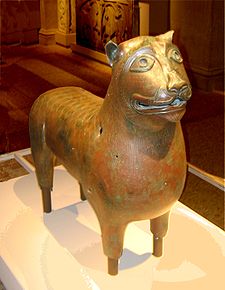 A bronze lion sculpture attributed to an Italo-Norman artist. Now in the Metropolitan Museum of Art.
A bronze lion sculpture attributed to an Italo-Norman artist. Now in the Metropolitan Museum of Art.
In the visual arts, the Normans did not have the rich and distinctive traditions of the cultures they conquered. However, in the early 11th century the dukes began a programme of church reform, encouraging the Cluniac reform of monasteries and patronising intellectual pursuits, especially the proliferation of scriptoria and the reconstitution of a compilation of lost illuminated manuscripts. The church was utilised by the dukes as a unifying force for their disparate duchy. The chief monasteries taking part in this "renaissance" of Norman art and scholarship were Mont-Saint-Michel, Fécamp, Jumièges, Bec, Saint-Ouen, Saint-Evroul, and Saint-Wandrille. These centres were in contact with the so-called "Winchester school", which channeled a pure Carolingian artistic tradition to Normandy. In the final decade of the eleventh and the first of 12th century, Normandy experienced a golden age of illustrated manuscripts, but it was brief and the major scriptoria of Normandy ceased to function after the midpoint of the century.
The Wars of Religion in the 16th century and French Revolution in the eighteenth successively destroyed much of what existed in the way of the architectural and artistic remnant of this Norman creativity. The first, by their violence, caused the wanton destruction of many Norman edifices; and the second, by its assault on religion, caused the purposeful destruction of religious objects of any type and by its destabilisation of society resulted in rampant pillaging.
By far the most famous work of Norman art is the Bayeux Tapestry, which is not a tapestry but a work of embroidery. It was commissioned by Odo, the Bishop of Bayeux and first Earl of Kent, employing natives from Kent who were learned in the Nordic traditions imported in the previous half century by the Danish Vikings.
In Britain, Norman art primarily survives as stonework or metalwork, such as capitals and baptismal fonts. In southern Italy, however, Norman artwork survives plentifully in forms strongly influenced by its Greek, Lombard, and Arab forebears. Of the royal regalia preserved in Palermo, the crown is Byzantine in style and the coronation cloak is of Arab craftsmanship with Arabic inscriptions. Many churches preserve sculptured fonts, capitals, and more importantly mosaics, which were common in Norman Italy and drew heavily on the Greek heritage. Lombard Salerno was a centre of ivorywork in the 11th century and this continued under Norman domination. Finally should be noted the intercourse between French Crusaders traveling to the Holy Land who brought with them French artefacts with which to gift the churches at which they stopped in southern Italy amongst their Norman cousins. For this reason many south Italian churches preserve works from France alongside their native pieces.
Music
Normandy was the site of several important developments in the history of classical music in the 11th century. Fécamp Abbey and Saint-Evroul Abbey were centres of musical production and education. At Fécamp, under two Italian abbots, William of Volpiano and John of Ravenna, the system of denoting notes by letters was developed and taught. It is still the most common form of pitch representation in English- and German-speaking countries today. Also at Fécamp, the staff, around which neumes were oriented, was first developed and taught in the 11th century. Under the German abbot Isembard, La Trinité-du-Mont became a centre of musical composition.
At Saint Evroul, a tradition of singing had developed and the choir achieved fame in Normandy. Under the Norman abbot Robert de Grantmesnil, several monks of Saint-Evroul fled to southern Italy, where they were patronised by Robert Guiscard and established a Latin monastery at Sant'Eufemia. There they continued the tradition of singing.
Rulers
- List of Dukes of Normandy
- List of Counts and Dukes of Apulia and Calabria
- List of Counts of Aversa
- List of Princes of Capua
- List of Dukes of Gaeta
- List of Princes of Taranto
- List of monarchs of Sicily
- List of Princes of Antioch
- List of Officers of the Principality of Antioch
- Second House of Lusignan
- List of Kings of England
- List of Kings of Scots
See also
References
- ^ The Normans are considered a people of mixed origins, not to be equalled to Vikings; see for instance H.M. Thomas, The English and the Normans: Ethnic Hostility, Assimilation, and Identity (2003), 38 ("Felice Lifshitz has shown ... what an important role the cult of Romanus played in the Viking reconfiguration of themselves as Christian Normans and in the merging of conquerors and conquered as one people."), and D. Crouch, The Normans: The History of a Dynasty (2002), 20 (remarking that by the 960s, the Normans were considered "no longer the 'Northmen of the Seine', but a people of a variety of descents gathered into one political unit within specific borders".)
- ^ http://www.britannica.com/EBchecked/topic/418283/Norman
- ^ M. Chibnall, The debate on the Norman Conquest (1999), 2: "In Normandy the conquering northmen had assimilated ... the indigenous Frankish and Gallo-Roman peoples..."
- ^ T. F. HOAD, English Etymology, Oxford University Press Paperback, 1993. p. 315.
- ^ Albert Dauzat, Jean Dubois, Henri Mitterand, Larousse étymologique, éditions Larousse, 1971. p. 497.
- ^ Etymology of Norman (French)
- ^ Malaterra in Peter Gunn, Normandy: Landscape with Figures.
- ^ Neveux, Francois. The Normans, p.5. Constable & Robinson Ltd. Translation copyright © Howard Curtis 2008.
- ^ Jerry Dupont, The common law abroad: constitutional and legal legacy of the British empire - Malta - Wm. S. Hein Publishing, 2001, p. 793.
- ^ Paul Stephenson, Byzantium's Balkan frontier: a political study of the Northern Balkans, 900–1204, Cambridge University Press, 2000, Page 167. [1]
- ^ Flori 1999 (french), p. 131.
- ^ Flori 1999 (french), p. 132.
- ^ Flori 1999 (french), p. 132.
- ^ Flori 1999 (french), p. 132.
- ^ Flori 1999 (french), pp. 133-134.
- ^ Flori 1999 (french), p. 134.
- ^ Flori 1999 (french), pp. 134–136.
- ^ Flori 1999 (french), p. 138.
- ^ Flori 1999 (french), p. 138.
- ^ Flori 1999 (french), p. 137.
- ^ Flori 1999 (french), p. 137.
- ^ Flori 1999 (french), p. 138.
Sources
Primary
- Elisabeth van Houts, ed. The Normans in Europe Manchester Medieval Sources, Manchester 2000.
- Medieval History Texts in Translation from the University of Leeds.
Secondary
- Bates, David. Normandy before 1066, London 1982
- Chalandon, Ferdinand. Histoire de la domination normande en Italie et en Sicilie. Paris, 1907.
- Chibnall, Marjorie. The Normans, The Peoples of Europe, Oxford 2000
- Crouch, David. The Normans: The History of a Dynasty. Hambledon & London, 2003.
- Douglas, David. The Norman Achievement. London, 1969.
- Douglas, David. The Norman Fate. London, 1976
- Flori, Jean (1999 (French)), Richard Coeur de Lion: le roi-chevalier, Paris: Biographie Payot, ISBN 978 2 2288 9272 8
- Gillingham, John. The Angevin Empire, end ed., London 2001.
- Gravett, Christopher, and Nicolle, David. The Normans: Warrior Knights and their Castles. Osprey Publishing: Oxford, 2006.
- Green, Judith A. The Aristocracy of Norman England. Cambridge University Press, 1997.
- Gunn, Peter. Normandy: Landscape with Figures. London: Victor Gollancz, Ltd, 1975.
- Harper-Bill, Christopher and Elisabeth Van Houts, eds. A Companion to the Anglo-Norman World Boydell Press. 2003
- Haskins, Charles H. Norman Institutions, 1918
- Maitland, F. W. Domesday Book and Beyond: Three Essays in the Early History of England. 2d ed. Cambridge University Press, 1988. (feudal Saxons)
- R. Mortimer, Angevin England 1154–1258, Oxford 1994.
- Muhlbergher, Stephen, Medieval England (Saxon social demotions)
- Norwich, John Julius. The Normans in the South 1016–1130. Longmans: London, 1967.
- Norwich, John Julius. The Kingdom in the Sun 1130–1194. Longman: London, 1970.
- Robertson, A. J., ed. and trans. Laws of the Kings of England from Edmund to Henry I. AMS Press, 1974. (Mudrum fine)
- Painter, Sidney. A History of the Middle Ages 284−1500. New York, 1953.
- Lucas Villegas-Aristizábal ,"Algunas notas sobre la participación de Rogelio de Tosny en la Reconquista Ibérica", Estudios Humanísticos de la Universidad de Leon, III, 2004, pp. 263–74. http://dialnet.unirioja.es/servlet/articulo?codigo=1078914
- Lucas Villegas-Aristizábal, 2007. "Norman and Anglo-Norman Participation in the Iberian Reconquista." PhD thesis, University of Nottingham.
- Lucas Villegas-Aristizábal, "Roger of Tosny's adventures in the County of Barcelona", Nottingham Medieval Studies LII, 2008, pp. 5–16.
- Thompson, Kathleen, "The Norman Aristocracy before 1066:the Example of the Montgomerys, Historical Research vol. 143, pp. 251–263,October 1987.
External links
- Dudo of St. Quentin's Gesta Normannorum, English translation
- The Normans, a European People, by the European Commission
- Breve Chronicon Northmannicum (Latin).
- The Normans Jersey heritage trust (pdf)
- Wales History — The Norman Wars.
- Patrick Kelly The Normans: their history, arms and tactics
- Regia Anglorum Who were the Normans?
Categories:- Ethnic groups in Europe
- Normans
- Germanic peoples
- North Germanic peoples
Wikimedia Foundation. 2010.


